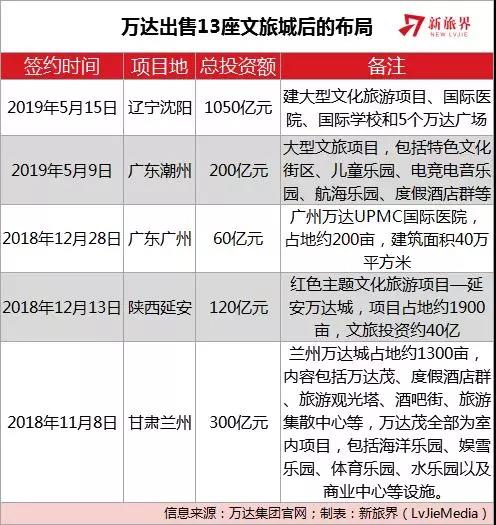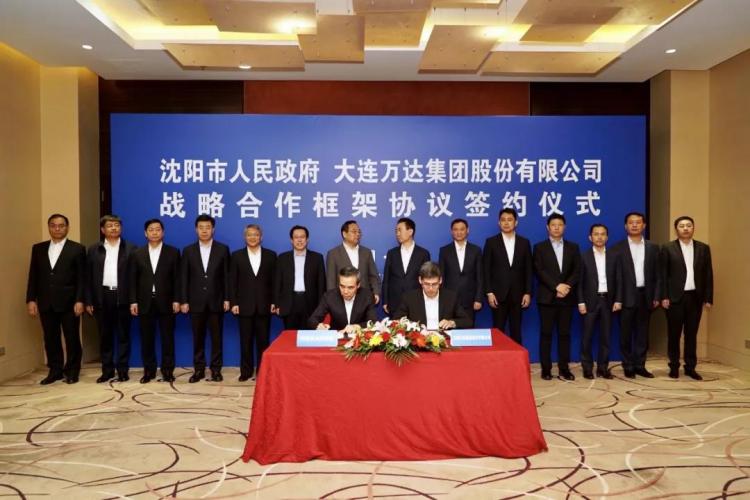Invested over 100 billion in Shenyang, 20 billion in Chaozhou, and 1.34 billion in land acquisition in Guangzhou… Wanda Group, which sold 13 Wanda Cultural Tourism Cities last year, came back in 2019.
But unlike the rapid opening of Wanda Cultural Tourism City in the past, Wanda no longer “specializes” in the cultural and tourism sector, but has found a “new love”-big health. “The big health industry is the strategic industry that Wanda focuses on.” Wang Jianlin, chairman of Wanda Group, revealed in January this year that universities and medical care are the two crown jewels of the big health service industry.
“Holding” cultural tourism and “pampering” big health?
Since 2018, Wanda has gradually slowed down and rekindled its old love for cultural tourism. Wang Jianlin and others have publicly stated on many occasions that they are still optimistic about the domestic tourism industry. Soon, at the end of 2018, Wanda Group signed a contract with the Yan’an Municipal Government. It plans to invest 12 billion yuan to create a red-themed cultural tourism project.

We do not give up on cultural tourism, but the focus is not entirely on cultural tourism, but on cultural tourism, general health, business and other formats . Except for Yan’an Wanda City, which has a total investment of 12 billion yuan, which can be counted as a single cultural tourism project, the focus of Wanda Group’s subsequent investment projects has basically deviated from cultural tourism.
On May 15th, Wanda Group’s official website reported that on the basis of the original 25 billion yuan, it will invest another 80 billion yuan in Shenyang to build a world-class large-scale cultural tourism project, a world-class international hospital, a world-class international school and five Wanda square. On May 20, Wanda won a land in Huangpu District, Guangzhou, with a base price of 1.34 billion yuan, covering an area of about 133,300 square meters. The land will be used to build Wanda University of Pittsburgh Medical Center (UPMC) International Hospital.
This can also confirm Wang Jianlin’s statement at the beginning of the year that big health is an industry that Wanda is fully entering. “By 2019, all the big health international hospitals in five first-tier cities including Guangzhou and Chengdu will be established, and at least three projects will start construction.” Wang Jianlin said, “For example, big health, Wanda did not have an advantage before, but now we have excellent partners. Competitiveness will soon be established.”

On May 15, the Shenyang Municipal Government signed an agreement with Wanda Group, and Wanda Group will invest another 80 billion yuan in Shenyang. Source: Wanda Group
In this regard, Lin Huanjie, president of the China Theme Park Research Institute, told LvJieMedia that there is no contradiction in the combination of cultural tourism and the medical industry. Foreign countries have long had a medical tourism model, especially in Indonesia, Thailand and other Southeast Asian regions. Do health care tourism industry. “Currently, this kind of model in China is not new, but there are still not many. If Wanda can truly combine cultural tourism with health care, it should be very popular among ordinary people.”
Judging from the current progress, there may be no suspense about the landing of Wanda’s big health hospitals in Shenyang and Guangzhou. According to Wanda Group’s official news, Wanda Group’s first international hospital – “Chengdu Wanda UPMC International Hospital” started construction in 2018. This is not far from the goal of “starting construction of at least three major health hospital projects” proposed by Wang Jianlin at the beginning of the year.
Where does Wanda’s cultural tourism industry go from here?
The cultural tourism industry is not abandoned, but the focus of cultural tourism has obviously been cut . At the annual work summary meeting in early 2019, Wang Jianlin’s explanation of the cultural and tourism sector was obviously weakened, and he pointed out more problems. Regarding the development ideas of cultural tourism companies in 2019, Wang Jianlin said that to innovate new models of cultural tourism projects, there are problems in the old cultural tourism product planning, content, and profits; cultural tourism products must be innovative and researched, and cannot be static.
Since the sale of 13 Wanda Cultural Tourism Cities and their management companies to Sunac, Wanda Cultural Tourism Group has been left with very few personnel. As early as January 22 this year, an internal source broke the news to New Travel Industry that Jin Minhao, the former president of Wanda Cultural Tourism, had recently resigned and his whereabouts are unknown. Wanda Cultural Tourism Group headquarters has not many staff left.
Previously, Wanda’s internal personnel told New Travel Industry that they would continue to deploy Wanda Cultural Tourism City if they saw the opportunity. But what is certain is that Wanda’s next operating model may change, and it will no longer continue the previous model of large investment and heavy assets. According to the official information of Wanda Group, through three years of research, it has innovated a new model of China’s big health industry with top hospitals as the core and integrated medicine, health care, business, and training industries. From the perspective of industry insiders, the future cultural and tourism industry is only an entry point for Wanda, and the combination of tourism and health care will be an important direction for Wanda to “handle” the tourism sector.
Lin Huanjie believes that if Wanda can truly combine medical treatment and cultural tourism, tourists can not only recuperate their bodies, but also travel leisurely. to balance investments. Previously, Yang Honghao, deputy director of the Industry Institute of the China Tourism Academy, told the New Travel Industry that Wanda will continue to develop the cultural tourism industry, innovate and upgrade the original model, and will continue to engage in real estate “blood-enriching” cultural tourism projects, because cultural tourism projects A lot of money is required.

On May 9, Wanda Group signed an agreement with the Chaozhou Municipal Government, planning to invest 20 billion yuan in the construction of large-scale cultural tourism projects in Chaozhou, Guangdong. Source: Wanda Group
For projects in Shenyang and other places invested by Wanda, what is the proportion of its investment in the cultural and tourism sector? How will Wanda’s cultural tourism and health care industry balance in the future? In this regard, New Travel Industry has consulted with relevant departments of Wanda, and has not responded directly as of press time.
According to information released on Wanda’s official website, the Shenyang project with a total investment of 105 billion yuan will build large-scale cultural tourism projects, international hospitals, international schools and five Wanda Plazas. Among them, the large-scale cultural tourism project covers an area of 4,000 mu, including cultural tourism city, sports park, resort hotel group, etc.; the international hospital has a construction area of about 400,000 square meters, including medical treatment, rehabilitation, and health care, and will be managed by the world’s top hospitals The team and technical experts manage and operate; the international school will introduce world-class primary and secondary education brands to build a 12-year consistent boarding school; 5 Wanda Plazas are located in Shenbei, Dadong and other areas to fill the gap in the lack of large-scale modern commercial facilities in the above areas.
Wanda’s precise transformation
Since 2019, Wang Jianlin has made public appearances more frequently than in the previous two years. According to the public information of Wanda Group, Wang Jianlin met with the main leaders of three local governments in May, and met with local leaders nine times in April. Among them, some media reports pointed out that in April, Wang Jianlin met with Liu Xiaotao, secretary of the Guangdong Chaozhou Municipal Party Committee, and Zhang Lei, member of the Standing Committee of the Liaoning Provincial Party Committee and secretary of the Shenyang Municipal Party Committee. 23 days, the Shenyang project took 18 days.
Of course, the project may take more than ten or twenty days from negotiation, investigation to contract signing. Before the meeting of the main person in charge of the project, the teams of both parties have also completed a lot of work. However, in the eyes of industry insiders, the projects in Chaozhou and Shenyang are relatively fast. In addition to Wang Jianlin’s frequent travel and large investment, after the liquidity problem has passed, Wanda Group, which is looking for future layout, is now starting to expand again.
In fact, Wanda Group has experienced many transformations in history, and each time it was ahead of the times, and thus reaped a lot of rewards . For example, in 1993, Wanda stepped out of Dalian to expand in other places, which was an unconventional move at the time. The first-generation Wanda Plaza was launched in 2001, and the second-generation Wanda Plaza was born in 2004. Wanda completed the transformation from residential real estate to commercial real estate. In 2005, Wanda entered the film and television culture industry, opened its first Wanda cinema, and successively formed a complete film and television industry chain including theaters, theater chains, film and television investment, and production. At the same time, it acquired the American Legendary Films to complete its international transformation. In 2005, China’s annual movie box office was less than 4 billion yuan. In 2018, this figure has reached 60.9 billion yuan. As the tide rises, all boats rise, and Wanda has become an international film and television giant. In 2012, Wanda started to enter the cultural tourism industry. Although it was not too early to enter the market, its execution ability was extremely strong, and its expansion speed was astonishing. It led a number of real estate companies to start the transformation of cultural tourism. Unfortunately, the expansion is too fast, the debt is too high, and the overseas investment policy is tightened, financial deleveraging, etc., and we have to reluctantly give up.

Wanda Group and UPMC of the United States jointly run an international hospital. Source: Wanda Group
Today, the combination of tourism and medical care is a new model and direction that Wanda will try. The reason why Wanda cannot continue with its previous cultural tourism transformation strategy is that in 2019, the situation is completely different from that in 2012. The most important thing for a cultural tourism project is a good location, which needs to radiate enough mid-to-high-end consumer groups, usually around first- and second-tier cities. Now, after 7 years of staking the land, these good positions have been occupied by other opponents, and it will be half the effort to force the layout.
At present, Wanda’s goal is to complete the corporate transformation in 2020. The idea is mainly in three aspects : First, focus on service consumption. In the future, Wanda will firmly grasp the service consumption and experiential consumption industries. Wanda is focusing on the service industry; secondly, focusing on advantageous industries. Another key point of Wanda’s transformation strategy adjustment is to sort out existing industries and focus on industries that have competitive advantages at home and abroad, or will soon form competitive advantages, such as big health; The third is to engage in high-threshold business. The international hospitals that will be focused on in 2019 may become an important part of Wanda’s future high-end consumer industry.
How do you view Wanda’s choice of strategic direction this time? From the perspective of industrial space, the potential of big health is huge, no less than that of cultural tourism. With the increase of per capita income level and the trend of population aging, domestic demand for health is destined to become stronger and stronger. For large-scale giants, this is a good track.
However, just like the cultural tourism project, the big health project is not a “short-term, flat and fast” real estate money-making model. It requires long-term cultivation and refined operation. Whether Wanda can adapt to this rhythm needs further observation.




